Contact GLIDE
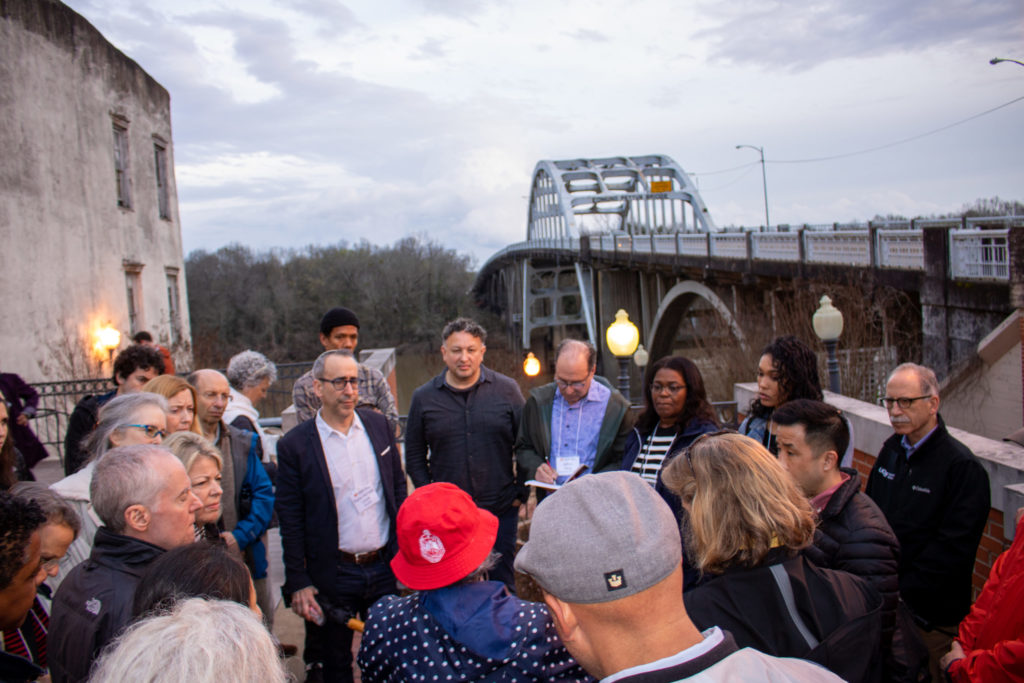
A personal journey through collective history, toward a racial justice practice
by Chris Dowd
Immediately after I returned from this year’s GLIDE-led justice pilgrimage to Alabama, social distancing was in full effect. Suddenly, despite the powerful memories I carried, my period of guided reflection about race in America felt overshadowed by our global health emergency. Soon, the data around testing, infection rates, and deaths came to highlight the inequity of service and care. Then, the whole world witnessed Amy Cooper leverage her power against a Black man bird watching in Central Park. Days later came the murders of Breonna Taylor and George Floyd—at the hands of those entrusted to protect and serve. I started to feel a greater urgency to share the lessons from my experience in Alabama.
I believe we are more than the stories we tell ourselves. One of the stories I tell myself is that I grew up in San Francisco, white, the youngest of three siblings and the son of two highly educated parents. I was afforded the privileges of private education and strong role models in my community. This is part of my story, just as most of what we know of our friends and colleagues is only part of their story. It takes time and a shared context to see a more complete story. This is true not only at the individual level, with friends and family, but also at the level of our collective consciousness and history as a country. GLIDE Church has always been a place for this in San Francisco and the Tenderloin, at critical moments in modern history, to reflect and to question.
I grew up in San Francisco, but left for high school, college, and my first job. Returning in 2017, I was immediately drawn to GLIDE by the gravity of its courageous history, and its purpose: unconditional love. It quickly became the center of gravity for my new chapter in my old city.
I started volunteering on the Harm Reduction team, handing out clean needle kits and leading Narcan trainings for the treatment of narcotic overdoses. This experience on the front lines of San Francisco’s fight against the opioid crisis could not have been more different from my day job just a few blocks away at Google. I quickly saw the disconnect: that almost no one in my professional network had an understanding or connection to this life-changing work.
To bridge these communities, I joined the Legacy Committee, GLIDE’s young professionals group, which works to engage young leaders from San Francisco’s evolving workforce and youth culture in GLIDE’s mission. In doing so, the Legacy Committee supports their learning around the nuances of systems that govern our streets as well as GLIDE’s historic role at the center of San Francisco’s progressive movements.
As the 2020 Co-Chair of the Legacy Committee, I was invited to join Rabbi Michael Lezak and Isoke Femi, of GLIDE’s Center for Social Justice, on GLIDE’s annual Social Justice Pilgrimage to Montgomery, Alabama. Over 100 intergenerational leaders from GLIDE, SFPD, UCSF, The Kitchen, and local government participated.
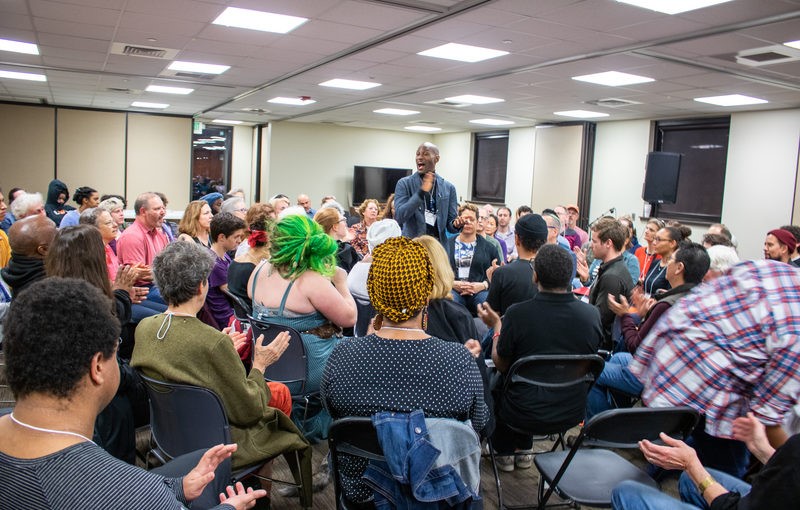
Nearly two months before leaving for Alabama, our group met in Freedom Hall on Thursday nights, below the GLIDE Sanctuary. The physical space is characterized by white linoleum floors, stacks of foldable chairs, and the regular sound of overhead MUNI bus wires sparking as the buses climb up Nob Hill. For me, Freedom Hall is also a divine space of unlearning. In 2018, for example, it hosted a full-scale mock-up of an overdose prevention / safe consumption site, a temporary construction made to display the public health benefits of this proven health intervention, still largely unknown in the U.S., to regulators, community leaders, and journalists. This space was our classroom, where we would start the process of reconciling the incomplete individual and collective stories about race in America that many of us have learned, and continue to internalize within our families and communities.
Our practice and study were multisensory. Before every meeting, we were led in song by Vernon Bush, the musical director of the GLIDE Ensemble. Our reading list was robust. I was taken by the words of Ta-Nehisi Coates on reparations, then by Michelle Alexander’s account of the state of criminal injustice, and later by a 60 Minutes interview from the 1980s with Bryan Stevenson describing the work that became the Equal Justice Initiative. I will never forget the feeling of taking deep breaths before multiple pages of Anthony Ray Hinton’s story, a man wrongly kept on death row for three decades, whom we would later meet on our trip to Alabama. These works were offered as the minimum expectation for participation in our group dialogue. Everyone did their homework.
Language is the cornerstone of any shared history. At the start of each meeting, Rabbi Lezak introduced Hebrew phrases: Kavvanah, meaning intentionality or direction of the heart; Chag, a place you must visit in order to understand a history; Kriah, the experience of tearing your garment after someone dies in an effort to mend in grief. He was teaching us the ways in which Hebrew has evolved to more accurately express the trauma and triumph that is core to their history. I came to recognize, and be motivated by the vacancies in my own language as I tried to understand these unfamiliar feelings and experiences.
Just before we left for Alabama, I met with Minister Marvin K. White, GLIDE’s fearless faith leader, to see if he had any advice on preparing for the journey. We spoke about the importance of active listening, and the reality that, so often, our public discourse does not allow for spirituality or religion to take center stage. He encouraged me to listen deeply, have side conversations, and let the walls talk.
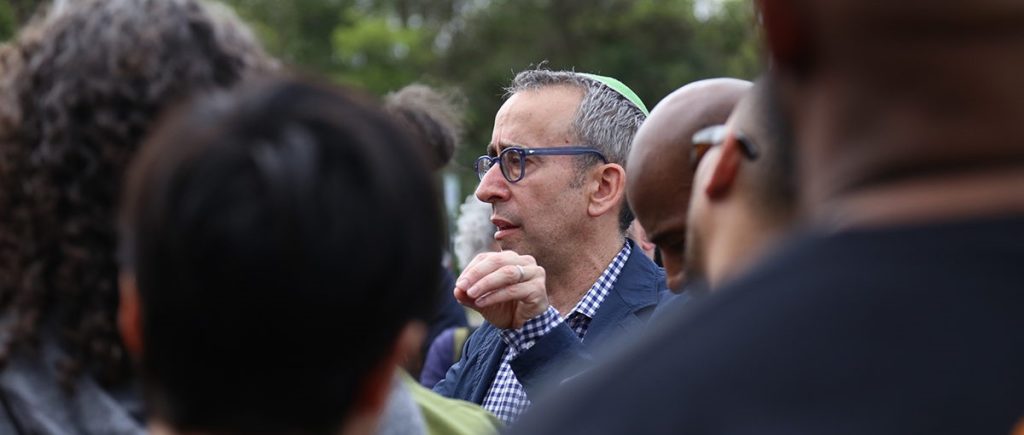
A few days later, I was on a Greyhound from Birmingham to Montgomery passing Waffle Houses and billboard psalms. I read through past notes from our gatherings in Freedom Hall, reaching to synthesize and remember what exactly my purpose was, my why, for joining this trip. I scribbled down some scattered thoughts about bearing witness, being an ally, and having a more complete vision of my country’s past, knowing full well that nothing written on that page would equip me for, shield me from, or even enable me to name what I was going to experience in the coming days. I was ashamed at my eagerness to intellectualize and jump ahead to imagine how this experience might “fit” into my life, recognizing, even at the time, the privilege that enables such an instinct. So, I drew myself against the window and tried to just be present, as I would try to do countless times in the coming days.
Just before sundown I stepped off the Greyhound onto Maxwell Boulevard, one of the first streets along the Alabama River. That evening, we gathered in the hotel lobby occupying our in-between time with light banter about the slower pace of life best captured through the 90-second timer at a nearby crosswalk.
That night, we walked to the basement of the Dexter Baptist Church, which would come to be our local Freedom Hall, the place where a young 25-year-old Martin Luther King, Jr. got his start as a minister, and where the organizers of the Montgomery Bus Boycott would hold late night gatherings. Just across the street is the Southern Poverty Law Center, demonstrating the power of proximity, and the rich history of collaboration between judicial activists and spiritual leaders.
Montgomery is the birthplace of modern civil rights activism in America, so casual encounters with residents led to powerful stories and important context. Through a side conversation with a tour guide from a local nonprofit, our group was able to meet the guide’s father, Chap. Chap was born and raised in Alabama in the 1950s, before migrating to New York City as a result of Alabama State University’s segregation policies.
Chap remembers how then-Governor George Wallace stood on the steps of the state university pronouncing his favorite catch phrase, “segregation today, segregation tomorrow, segregation forever.” Around that same time, the murder of the four girls at Birmingham’s 16th Street Baptist Church turned Chap’s frustration into rage, motivating his decision to head north.
History books often describe George Wallace as a young man desperate for power. He began his career as a progressive judge until it proved politically stale, at which point he turned to channeling fear and white supremacy, later becoming a seminal character in our historical through-line from slavery to the modern era. You can imagine the complexity Chap faced when, decades later, George Wallace offered him a job, appointing him to lead ministerial services for inmates on death row. Chap would accept, returning to Alabama to deliver last rites for over two decades.
Now, in his early 80s, Chap addressed our group, in the basement of Dexter Baptist Church, with a simple message: It is more difficult to forgive than it is to hate. I could not begin to imagine what it takes for a man like Chap, who has seen true evil, to arrive at that lesson. The next day would continue to expose more challenging truths.
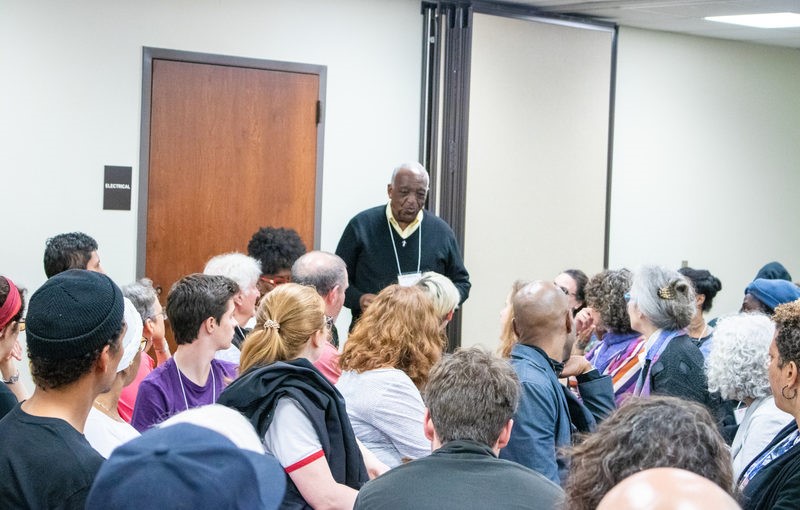
The Equal Justice Initiative (EJI) and its Legacy Museum are housed in repurposed slave barracks. Just 200 yards east is where the slave market once was, and 50 yards west lies the train station, its tracks laid by slaves for their inevitable transit and sale throughout the American South. I wrote in my journal that morning about the elusive fact that our public spaces reflect and contain our history, values, and collective memory. It reminded me of the violence in Charlottesville in 2016, following attempts to remove confederate statues and iconography associated with the same painful and oppressive history. The statue of Robert E. Lee in Charlottesville sparked a series of events that allowed the world, for a moment, to peek behind the curtain at a painful American history and culture. In the case of EJI, they chose to reclaim spaces that you might walk by a thousand times before considering their original use, and to build new monuments there.
In Montgomery, a city whose very cobblestones and roundabouts evoke similar traumas, there is no single monument you can point to, no one thing you can get rid of—everything about the city breathes its past. Just as the history of slavery cannot be removed from the fabric of Montgomery, it also has not vanished from our institutions. EJI and its powerful Legacy Museum exist to bring about a more complete American narrative, one that makes clear that slavery, far from ending in 1865, has only evolved. There is a clear chronology through American history from slavery to mass incarceration and the type of policing that grips and terrorizes Black communities across this country. EJI is trying to help America heal and move forward by addressing old, suppressed truths.
For example, Bryan Stevenson and EJI make it possible for stories and voices like Anthony Ray Hinton’s to reach a national audience. Anthony Ray Hinton was wrongly convicted and sentenced to death row in 1985. A simple ballistics review would have swiftly undermined the decades-old verdict, but the state DA rejected his appeal in the early 2000s, condemning him to another 15 years before Bryan Stevenson and EJI took on his case. Finally freed from death row, Hinton expressed his tremendous resilience in the face of such persecution in these words, “They took my thirties, they took my forties, they took my fifties, but they can’t take my joy.”
Yet, it was impossible to hear his story and not feel rage towards the extrajudicial measures that robbed Anthony Ray Hinton of his freedom. To date, he has never received an apology from the state for the wrongful conviction. As he saw it, this was no mistake. “No one with power will ever apologize to someone with no power,” he told us.
At the end of our first night in Montgomery, Nathaniel Woods, a young Black man who sat on death row for over 15 years, was killed in an electric chair just a few hours’ drive from us. I feel disoriented and horrified when I think about the thousands of wrongly accused men and women of color who are unjustly pulled from their communities in silence, whose suffering is too diffuse and systemic to warrant a thumbnail on your mobile feed. I am certain I would not have heard of Nathaniel Woods had I not been in Montgomery at that time, and that is part of EJI’s mission, to raise awareness around these less-publicized acts of injustice.
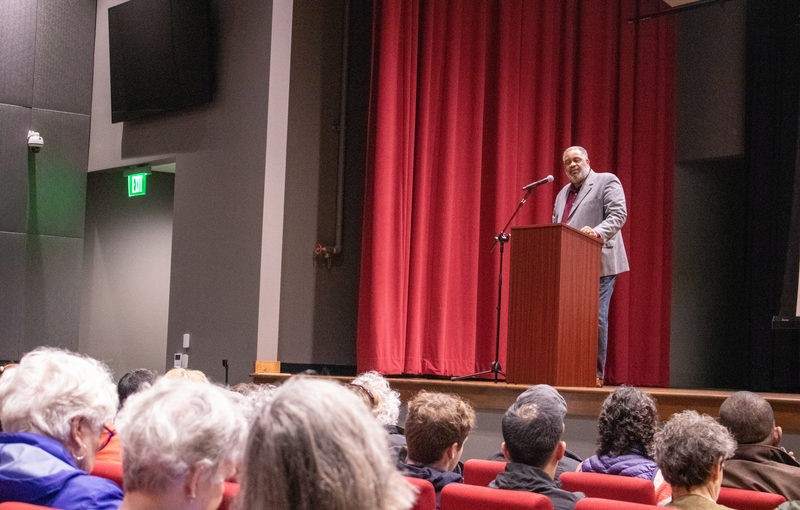
I was in a constant state of unlearning. Walking to our next group gathering, I stumbled on a painted iron plaque memorializing the Montgomery Bus Boycott. I knew about Rosa Parks, but not much else. I was surprised to learn that Claudette Colvin, a 15-year-old girl, was actually the first to sit in the whites-only section of the bus. The violent response from police and city officials inspired Rosa Parks, Martin Luther King, Jr., and others to create a plan to advance their cause. Mobilizing an alternative transit system sponsored by a Black-owned funeral service fleet for rural communities, and understanding that their movement could drain and strain the city’s budget largely by slashing bus fare revenues, the bus boycott forced the city’s hand: its pocket book or segregation.
The most powerful tool in the EJI-led movement is the Legacy Museum, which takes visitors from slavery to our modern-day criminal justice system and policing. No one forgets what it’s like to walk into the Legacy Museum for the first time. On the left hand of the ticket booth is a large map of the city of Montgomery in the 1860s. Just as the domestic slave trade was exploding, this sleepy Alabama town was becoming its headquarters. The map highlighted the businesses, transportation hubs, and organizations that propped up this economy. At the center was the slave market, efficient and inhumane to its core. As my finger tracked across the map, I recognized a name: Lehman Brothers—a bank which up until the 2008 financial crisis represented the pinnacle of America’s financial sector, “the smartest guys on The Street.”
I suspect their origins as the banker and lender for a growing slave industry in America were rarely mentioned at their first-year analyst orientation. And if they were still around today, I suspect that would still be the case. I mention this not exclusively to shame Lehman Brothers, or any other organization which may have had their origins in circumstances that we would rightly find morally abhorrent, but instead to recognize that it is the responsibility of citizens to ask the question, and then to ask the follow-up question, to try to understand the truth behind our institutions. Because there is no reason to suppose that injustice doesn’t still have offices on Main Street.
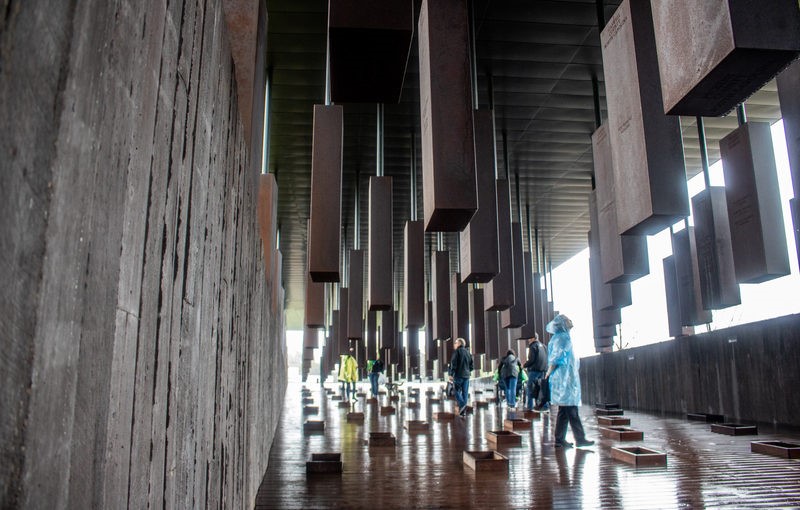
I share these stories because they represent small moments in my personal journey of understanding, and in my development of a Justice Practice that I can rely on. Travel, reading, and difficult conversations are useful ingredients in understanding a more complete American story and informing sustainable, direct, and indirect action. I believe my personal decisions and journey have an impact on my friends and family, and will meaningfully contribute to the collective growth and transformation that our children will come to expect and rightfully demand of us.
Inscribed on the side of the Legacy Museum is a quote by Maya Angelou: “History, despite its wrenching pain, cannot be unlived, but if faced with courage, need not be lived again.” There has never a better time than right now to dedicate ourselves to learning, practice and action.
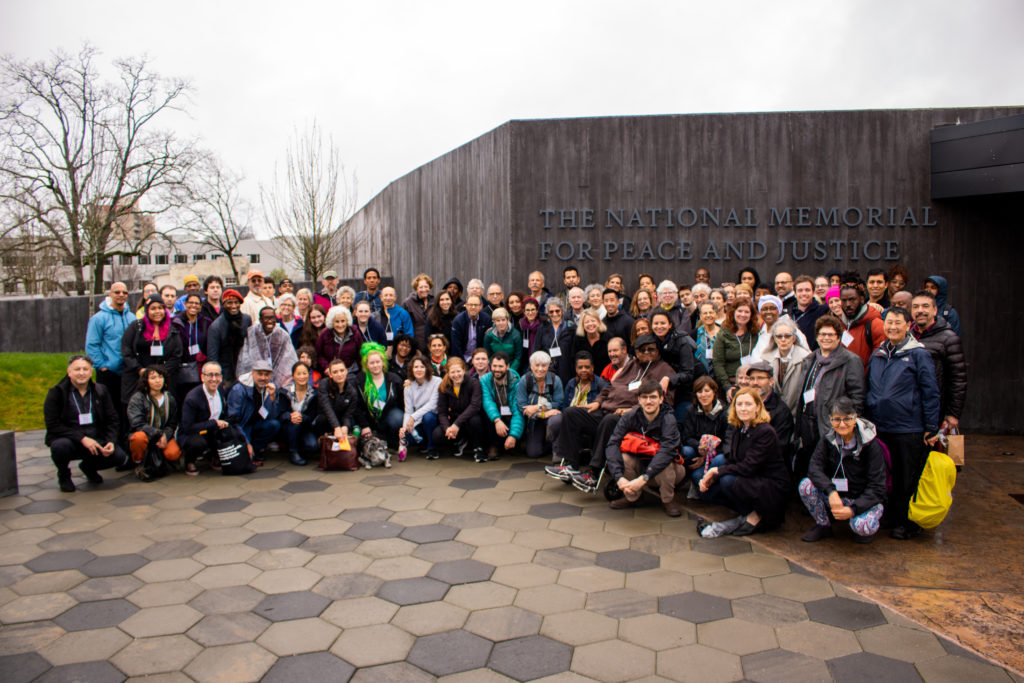
If you are a Bay Area–based young professional interested in learning more about the GLIDE Legacy Committee, please feel free to reach out to youngprofessionals@glide.org or go to our website. I would also encourage you to learn more about the mission and programs of EJI, Southern Poverty Law Center, GLIDE Ministry, and the GLIDE Center for Social Justice. Now is the time to support the experts, the local leaders and those with lived experience in the struggle against racism and injustice.
Chris Dowd is former Co-Chair of the GLIDE Legacy Committee.